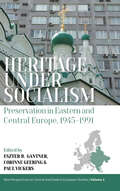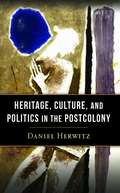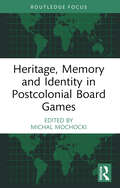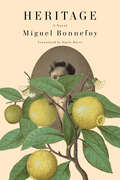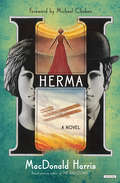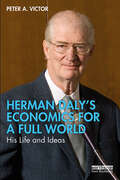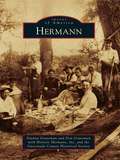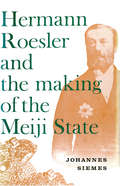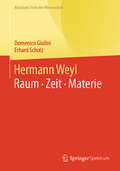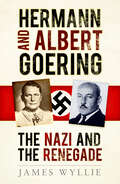- Table View
- List View
Heritage of the Sea: Famous Preserved Ships around the UK
by Peter C. SmithThe 21st century saw the naval power of Great Britain rise from that of an obscure island to that of a world-wide empire. British shipping and seamen dominated the globe for four centuries and the ships that explored the world and those which guarded them represent a unique treasure-trove of maritime history, unrivaled anywhere in the world. This book serves as an enthralling trawl through the heritage of the British shipping tradition, featuring images of iconic ships which have been preserved for all of us to marvel at. Each ship has a chapter dedicated to it, featuring a potted history and details of it's current location. A book which stirs a real desire to tour the sites it describes, it features full colour illustrations throughout, each of them evoking pride and diversity and inviting further study. Among the many vessels analysed and illustrated are HMS VICTORY, HMS WARRIOR, HMS CAVALIER, HMS BELFAST, HMS CAROLINE, HMS WELLINGTON, HMS ALIANCE, HMS TRINCOMALEE; the CHRYSANTHEMUM & PRESIDENT; the Royal Yacht BRITANNIA; the CUTTY SARK; the DISCOVERY; GYPSY MOTH II; GREAT BRITAIN; the MEDWAY QUEEN; the GANNET; the UNICORN; the CAMBRIA and many more.
Heritage under Socialism: Preservation in Eastern and Central Europe, 1945–1991 (New Perspectives on Central and Eastern European Studies #2)
by Eszter Gantner, Corinne Geering, and Paul VickersHow was heritage understood and implemented in European socialist states after World War II? By exploring national and regional specificities within the broader context of internationalization, this volume enriches the conceptual, methodological and empirical scope of heritage studies through a series of fascinating case studies. Its transnational approach highlights the socialist world’s diverse interpretations of heritage and the ways in which they have shaped the trajectories of present-day preservation practices.
Heritage under Socialism: Preservation in Eastern and Central Europe, 1945–1991 (New Perspectives on Central and Eastern European Studies #2)
by Eszter Gantner, Corinne Geering, and Paul VickersHow was heritage understood and implemented in European socialist states after World War II? By exploring national and regional specificities within the broader context of internationalization, this volume enriches the conceptual, methodological and empirical scope of heritage studies through a series of fascinating case studies. Its transnational approach highlights the socialist world’s diverse interpretations of heritage and the ways in which they have shaped the trajectories of present-day preservation practices.
Heritage, Conflict, and Peace-Building (ISSN)
by Lucas Lixinski Yujie ZhuHeritage, Conflict, and Peace-Building examines the possibilities arising from, and challenges associated with, transforming heritage from a casualty of conflict into an opportunity for peacebuilding.The contributors to this book, who hail from academia and practice, present case studies that shed light on the multifaceted factors and conditions influenced by diplomacy, nationalism, victimhood, and the roles of diverse institutional actors in fostering peace. They demonstrate the possibilities and pitfalls of the work heritage does for local communities, the nation-state, and the international community, when these different actors and their peace aspirations and agendas intersect. Looking at heritage and peace processes on all continents, the contributions in this volume amount to a compelling analytical account of how the discourses of heritage and peace connect, overlap, and diverge. They also emphasise that our shared aspiration for peace should not be taken for granted in a heritage context, and that it is incumbent upon heritage scholars and practitioners to be more intentional about the work they wish to do to promote peace.Heritage, Conflict, and Peace-Building will be of interest to scholars and practitioners working in heritage studies, transitional justice, museum studies, international relations, education, history, and law.
Heritage, Culture, and Politics in the Postcolony
by Daniel HerwitzThe act of remaking one's history into a heritage, a conscientiously crafted narrative placed over the past, is a thriving industry in almost every postcolonial culture. This is surprising, given the tainted role of heritage in so much of colonialism's history. Yet the postcolonial state, like its European predecessor of the eighteenth and nineteenth centuries, deploys heritage institutions and instruments, museums, courts of law, and universities to empower itself with unity, longevity, exaltation of value, origin, and destiny. Bringing the eye of a philosopher, the pen of an essayist, and the experience of a public intellectual to the study of heritage, Daniel Herwitz reveals the febrile pitch at which heritage is staked. In this absorbing book, he travels to South Africa and unpacks its controversial and robust confrontations with the colonial and apartheid past. He visits India and reads in its modern art the gesture of a newly minted heritage idealizing the precolonial world as the source of Indian modernity. He traverses the United States and finds in its heritage of incessant invention, small town exceptionalism, and settler destiny a key to contemporary American media-driven politics. Showing how destabilizing, ambivalent, and potentially dangerous heritage is as a producer of contemporary social, aesthetic, and political realities, Herwitz captures its perfect embodiment of the struggle to seize culture and society at moments of profound social change.
Heritage, Gentrification and Resistance in the Neoliberal City (Explorations in Heritage Studies #5)
by Chiara Valli Feras Hammami, Daniel JewesburyWhat happens when versions of the past become silenced, suppressed, or privileged due to urban restructuring? In what ways are the interpretations and performances of ‘the past’ linked to urban gentrification, marginalization, displacement, and social responses? Authors explore a variety of attempts to interrupt and interrogate urban restructuring, and to imagine alternative forms of urban organization, produced by diverse coalitions of resisting groups and individuals. Armed with historical narratives, oral histories, objects, physical built environment, memorials, and intangible aspects of heritage that include traditions, local knowledge and experiences, memories, authors challenge the ‘devaluation’ of their neighborhoods in official heritage and development narratives.
Heritage, Memory and Identity in Postcolonial Board Games
by Michal MochockiHeritage, Memory and Identity in Postcolonial Board Games is a unique edited collection that explores the interplay of heritage, memory, identity and history within postcolonial board games and their surrounding paratexts. It also examines critiques of these games within the gamer communities and beyond. Drawing on a range of international contributions, examples and case studies, this book shows how colonialism-themed games work as representations of the past that are influenced by existing heritage narratives and discourses. It also considers the implications of using colonial histories in games and its impact on its audience, the games’ players. Heritage, Memory and Identity in Postcolonial Board Games will be relevant to scholars and postgraduate students in the fields of game studies, game design or development, heritage studies, postcolonial criticism, media studies, and history. It will also be beneficial to practicing game developers.
Heritage, Nostalgia and Modern British Theatre
by Benjamin PooreThe Victorians, having once been seen as 'them', the age responsible for the mistakes of the past, were transformed by the new theatrical forms of the 1960s into 'us', a metaphor for what the nation thinks (and fears) about itself. And, since the 1980s and the rise of new biographical forms in the theatre, the emphasis has shifted further, from 'we' to 'me': plays about individuals, great and small, and their struggles for personal validation. This study argues powerfully that the stage portrayal of the Victorians in recent times is a key reference point in understanding notions of Britishness, heritage and nostalgia, and the profound politicisation of national identity over the last four decades. Using many examples drawn from theatre archives, and throwing new light on works by canonical playwrights like Bond, Edgar, and Churchill, it charts the decline in class-based narratives of the British people and the move towards plays reflecting a more atomised, individuated society, preoccupied with identity and the past but no longer able to provide a convincing account of itself as a nation.
Heritage, Photography, and the Affective Past (UCL Institute of Archaeology Critical Cultural Heritage Series)
by Colin SterlingHeritage, Photography, and the Affective Past critically examines the production, consumption, and interpretation of photography across various heritage domains, from global image archives to the domestic arena of the family album. Through original ethnographic and archival research, the book sheds new light on the role photography has played in the emergence, expansion, and articulation of heritage in diverse sociocultural contexts. Drawing on wide-ranging experience across the heritage sector and two international case studies – Angkor in Cambodia and the town of Famagusta, Cyprus – the book makes a major contribution to our understanding of the role photography has played and continues to play in shaping experiences and conceptualisations of heritage. One of the core aims of the book is to problematise and potentially redirect the varied usages of photography within current practice, usages which remain woefully undertheorised, despite their often-central role in shaping heritage. Ultimately, by focusing attention on a hitherto underexamined aspect of the heritage phenomenon, namely its manifold interconnections with photography, this book provides fresh insight to the making and remaking of the past in the present, and the alternative heritages that might come into being around emergent photographic forms and approaches. Heritage, Photography, and the Affective Past uses photography as a method of enquiry as well as a tool of documentation. It will be of interest to scholars and students of heritage, photography, anthropology, museology, public archaeology, and tourism. The book will also be a valuable resource for heritage practitioners working around the globe.
Heritage, Tourism, and Race: The Other Side of Leisure (Heritage, Tourism, and Community)
by Antoinette T JacksonHeritage, Tourism, and Race views heritage and leisure tourism in the Americas through the lens of race, and is especially concerned with redressing gaps in recognizing and critically accounting for African Americans as an underrepresented community in leisure. Fostering critical public discussions about heritage, travel, tourism, leisure, and race, Jackson addresses the underrepresentation of African American leisure experiences and links Black experiences in this area to discussions of race, place, spatial imaginaries, and issues of segregation and social control explored in the fields of geography, architecture, and the law. Most importantly, the book emphasizes the importance of shifting public dialogue from a singular focus on those groups who are disadvantaged within a system of racial hierarchy, to those actors and institutions exerting power over racialized others through practices of exclusion. Heritage, Tourism, and Race will be invaluable reading for academics and students engaged in the study of museums, as well as architecture, anthropology, public history, and a range of other disciplines. It will also be of interest to museum and heritage professionals and those studying the construction and control of space and how this affects and reveals the narratives of marginalized communities.
Heritage: A Novel
by Miguel BonnefoyA dazzling family saga, brimming with poetry and passion, that skillfully weaves together the private lives of individuals and major historical events in South America and Europe. The house on Calle Santo Domingo in Santiago de Chile, with its lush lemon trees, has sheltered three generations of the Lonsonier family. Having arrived from the harsh hills of France&’s Jura region with a single grape vine in one pocket and a handful of change in the other, the patriarch put down roots there in the late nineteenth century. His son, Lazare, back from World War I&’s hellish trenches, would live there with his wife and build in their garden the most beautiful aviary in the Andes. That&’s where their daughter Margot, a pioneering aviator, would first dream of flying, and where she would raise her son, the revolutionary Ilario Da. Like Lazare before them, they will bravely face the conflicts of their day, fighting against dictatorship on both sides of the Atlantic. In this captivating saga, Miguel Bonnefoy paints the portrait of an endearing, uprooted family whose terrible dilemmas, caused by the blows of history, reveal their deep humanity.
Herkimer Village (Images of America)
by Caryl A. Hopson Susan R. PerkinsThe village of Herkimer, incorporated on April 6, 1807, was the first village in Herkimer County and was named after Revolutionary War hero Gen. Nicholas Herkimer. First settled by the Palatine Germans in 1725, the village's ideal location at the juncture of the Mohawk River and West Canada Creek made it the focal point of the county, and it was soon designated the county seat. The village population grew with the development of mills and factories, prompting the construction of elaborate homes, churches, diverse shops, and the New York Central Railroad, which ran directly through the village center with four main line tracks. Herkimer Village provides a snapshot of the daily life and important events in this village's colorful and dynamic history.
Herma: A Novel
by MacDonald HarrisAn inventive historical novel that delves into the mysteries of gender identity, from the National Book Award–nominated author of The Balloonist. With a foreword by Michael Chabon As a child in Southern California at the dawn of the twentieth century, Herma exhibits an incredible talent for vocal mimicry. Her gift will eventually take her from the choir of her country church to the Paris Opera, thanks in no small part to the machinations of her daredevil agent. But there is a secret at the heart of their intimate relationship, in this opulent rags-to-riches tale full of excitement, sexual intrigue, and decadence, with cameos by Puccini and Proust, among others. &“Set in the first decades of the twentieth century, Harris&’ teeming novel explores the porous boundaries of gender identity. This inventive work will appeal to readers who are interested in the dual-gender theme. Opera lovers will also be intrigued.&” —Booklist &“Once I open any of MacDonald Harris&’s novels I find it almost impossible not to turn and read on, so delightful is the sensation of a sharp intelligence at work.&” —Philip Pullman, author of The Amber Spyglass
Herman Daly’s Economics for a Full World: His Life and Ideas
by Peter A. VictorAs the first biography of Professor Herman Daly, this book provides an in-depth account of one of the leading thinkers and most widely read writers on economics, environment and sustainability.Herman Daly’s economics for a full world, based on his steady-state economics, has been widely acknowledged through numerous prestigious international awards and prizes. Drawing on extensive interviews with Daly and in-depth analysis of his publications and debates, Peter Victor presents a unique insight into Daly’s life from childhood to the present day, describing his intellectual development, inspirations and influence. Much of the book is devoted to a comprehensive account of Daly’s foundational contributions to ecological economics. It describes how his insights and proposals have been received by economists and non-economists and the extraordinary relevance of Daly’s full world economics to solving the economic problems of today and tomorrow. Innovative and timely, this book will be of great interest to students, scholars, researchers, activists and policy makers concerned with economics, environment and sustainability.
Hermanas de la resistencia: Cómo una espía alemana, la esposa de un banquero y la hija de Mussoline burlaron a los nazis
by Tilar J. MazzeoLOS DIARIOS DE UN FASCISTA Y ARISTÓCRATA ITALIANO Y LA ODISEA DE TRES MUJERES PARA SALVARLOS DE LA GESTAPO. E n 1944 se hicieron públicos los diarios secretos de Galeazzo Ciano, ministro de Relaciones Exteriores de Italia, en los que registraba los crímenes y planes nazis de los que se enteraba en sus reuniones con ellos. Pero poco se sabe que tres mujeres arriesgaron sus vidas para que estos llegaran a los Aliados, quienes luego los usarían como evidencia contra los nazis en los juicios de Núremberg. Cuando Galeazzo fue apresado, Edda Mussolini les dio a Hitler y a su padre un ultimátum: liberar a su esposo o correr el riesgo de que filtrara los diarios a la prensa. Hitler y Mussolini los buscaron en vano durante meses. Posteriormente, Hilde Beetz, espía alemana cuya misión era seducir a Galeazzo para encontrar sus escritos, fue a su vez seducida por aquél y unió fuerzas con Edda. Una terceramujer se sumó a este increíble entramado —Frances de Chollet, espía casi accidental y esposa de un banquero estadounidense— cuando Edda huyó a Suiza con la ayuda de Hilde, después de que Galeazzo fuera ejecutado. Frances fue el último eslabón para hacer llegar los diarios a los estadounidenses y cumplir así el deseo de Galeazzo. A partir de una minuciosa investigación, Tilar J. Mazzeo nos muestra este momento histórico poco conocido, para hacernos ver que sin la participación de Edda, Hilde y Frances, uno de los documentos más importantes de la Segunda Guerra Mundial y que fue fundamental en los juicios de Núremberg sería, quizá, desconocido.
Hermann
by Washington Historical Society Don Graveman Dianna GravemanHermann, Missouri, was named for Hermann der Cherusker, a German folk hero of the first century who led a successful battle against the Romans that many feel changed the course of history. In 1837, the German Settlement Society of Philadelphia, whose members hoped to establish a colony where their German language and customs could be preserved, founded Hermann and named the town for the young warrior. By the turn of the century, Hermann was a thriving river port and growing wine producer. The Hermann American Viticultural Area was officially designated in 1983, one of the earliest to be recognized by the U.S. government. Hermann hosts many events each year, including Maifest, which featured a historic pageant in the years 1952 through 1964, and Wurstfest, a celebration of the art of German sausage making. Approximately a quarter of a million tourists visit Hermann each year to enjoy a taste of "Little Germany" in the heart of the American Midwest.
Hermann Hellers demokratischer Konstitutionalismus (Staat – Souveränität – Nation)
by Oliver W. Lembcke Verena FrickVon Haus aus Jurist und Staatsrechtslehrer, vertritt Hermann Heller einen demokratischen Konstitutionalismus, der die Wirklichkeit der Demokratie mit der Normativität des Rechts zusammendenkt. Was Hellers Werk dabei in besonderer Weise fruchtbar erscheinen lässt, ist die Verbindung von Staatsrechtslehre, Politikwissenschaft und Soziologie, die erst die komplexe Wirklichkeit der Demokratie erfahrbar macht. In seinen späten Weimarer Schriften – etwa zum Autoritären Liberalismus – zeigt sich Heller als Analytiker der Krise, der uns heute den Blick für die Herausbildung autoritärer Politikstrukturen insbesondere auf europäischer Ebene schärft. Neben dieser kritischen Perspektive auf die Konstellationen und Dynamiken der (zum Teil schleichenden) Autokratisierung politischer Prozesse lassen sich auf Grundlage des Hellerschen Werkes auch die Voraussetzungen gelingender demokratischer Stabilität benennen. Die Rekonstruktion dieses Ansatzes eines dezidiert demokratischen Konstitutionalismus steht im Zentrum des geplanten Sammelbandes.
Hermann Roesler and the Making of the Meiji State
by Johannes SiemesThat Imperial Japan closely resembled authoritarian Germany was no simple coincidence. This book explores the effect of German thought on nineteenth century Japan, focusing on Hermann Roesler-the most influential collaborator.The Meiji leadership was committed to an authoritarian form of government. At the same time it was also clearly committed to a constitutional system. The mid and late 1880's saw the efforts of Japan's most capable leaders directed to the formation and rationalization of this ambivalent system. Because German socio-political ideas played an important role in this process, it is necessary to examine closely the extent of German influences on the Japanese leaders.All the standard Western works on Meiji Japan refer in passing to the influence of German, and in particular of Prussian, political and legal theories. Of the many German scholars who worked in Japan during the mid-Meiji period who were responsible for weighty changes, Hermann Roesler is considered one of the most influential in regard to political thought. Employed by the Japanese government as adviser on legal affairs from 0878, he was until 1893 one of the most trusted and esteemed collaborators of Ito Hirobumi.
Hermann Von Helmholtz and the Foundations of Nineteenth-Century Science
by David CahanRepresents a significant contribution not only to Helmholtz scholarship but also to the history of nineteenth-century science and philosophy in general.
Hermann Weyl: Raum · Zeit · Materie (Klassische Texte der Wissenschaft)
by Erhard Scholz Domenico GiuliniHermann Weyls Raum · Zeit · Materie gehört zu den herausragendsten und gleichzeitig ungewöhnlichsten Texten der gesamten physikalisch-mathematischen Literatur des 20. Jahrhunderts. Entstanden ist Raum · Zeit · Materie aus Vorlesungen, die der Autor im Sommersemester 1917 an der Eidgenössisch-Technischen-Hochschule in Zürich hielt. Es war das erste systematische Lehrbuch der gerade erst durch Albert Einstein ersonnenen Allgemeinen Relativitätstheorie, entwickelte sich aber rasch innerhalb der 5 Jahre zwischen 1918 und 1923 zu einem Klassiker, der die Zeiten überdauern sollte. Auch nach 100 Jahren setzt die Weylsche Darstellung eines der anspruchsvollsten Gebiete der Physik einen Maßstab an Verständlichkeit ohne Aufgabe der Strenge, der seither nur selten wieder erreicht wurde. Damit richtet sich das Buch auch heute noch an alle, die ein tieferes Verständnis der Allgemeinen Relativitätstheorie anstreben und insbesondere nachvollziehen wollen aus welchen physikalischen Fragestellungen heraus sich diese bis heute so bewährte wie bewunderte Theorie entwickelt hat, auf welchen Grundprinzipien sie beruht und insbesondere, wie es zu den mathematischen Begriffsbildungen kam, derer sie sich bedient.In dieser neuen Ausgabe wird der Originaltext der 5. Auflage von 1923 mit manchen Ergänzungen aus vorherigen Auflagen abgedruckt. Ausführliche Kommentare der Herausgeber erläutern die historischen, mathematischen und physikalischen Hintergründe und ordnen den Weylschen Text in die heutige Forschungslandschaft ein.
Hermann and Albert Goering: The Nazi and the Renegade
by James WyllieThey were the most unlikely of siblings – one, Adolf Hitler’s most trusted henchman, the other a fervent anti-Nazi.Hermann Goering was a founder member of the Nazi Party, who became commander of the Luftwaffe, ordering the terror bombing of civilians and promoting the use of slave labour in his factories.His brother, Albert, loathed Hitler’s regime and saved hundreds – possibly thousands – across Europe from Nazi persecution. He deferred to Hermann as head of the family but spent nearly a decade working against his brother’s regime. If he had been anyone else, he would have been imprisoned or executed. Despite their extreme and differing beliefs, Hermann sheltered his brother from prosecution and they remained close throughout the war.Here, for the first time, James Wyllie brings Albert out of the shadows and explores the extraordinary relationship of the Goering brothers.
Hermanos de sangre: Historias de la 'Ndragheta la mafia más poderosa
by Nicola GratteriLa extraordinaria reconstrucción del universo criminal de la 'Ndrangheta', la mafia más poderosa y desconocida. La 'Ndrangheta calabresa siempre ha sido infravalorada, considerada un fenómeno criminal menor, casi folclórico. Solo sale a la luz pública en momentos de sanguinaria celebridad, como ocurrió en Duisburgo (Alemania) en 2007, en un salvaje ajuste de cuentas en el que murieron seis personas. Crecida y fortalecida en el silencio, tiene hoy ramificaciones en todas las regiones italianas y en los cinco continentes y contactos con las principales organizaciones terroristas y criminales del mundo. Nicola Gratteri y Antonio Nicaso son los mayores expertos mundiales sobre esta organización criminal, cuya evolución no ha anulado los antiguos rituales, que han sido readaptados, pero nunca descartados. Una liturgia en la que conviven el arcángel san Miguel y mitos ancestrales, invocaciones improbables al Evangelio y a la religión cristiana, y pintorescos rituales de iniciación centrados en el protagonismo del «vínculo de sangre». Un universo simbólico que puede parecer extraño e incluso delirante, pero que resulta muy útil para conservar una sola identidad en cualquier lugar y ocasión. Gratteri y Nicaso han logrado una extraordinaria reconstrucción de la historia y la atmósfera de un universo criminal de asombroso alcance y brutalidad. Reseñas:«El libro que revela la sangre, el dinero y los rituales de la poderosa 'Ndrangheta, una mafia que salió de las montañas para conquistar el mundo.»Roberto Saviano «La obra máxima, la piedra angular de lo que concierne a la 'Ndrangheta y su escalada al poder mundial de las organizaciones criminales.»Benny Calasanzio Borsellino
Hermanos!
by William HerrickThe Spanish Civil War was the last in Europe to be fought for idealistic reasons. When it ended, idealism had been totally and tragically defeated. Hermanos! is about the men and women who came to Spain as volunteers from every corner of the world--Germany, Ireland, the USA and Britain--to join the International Brigades in what they saw as a crusade against fascism. It is about the cruel war they fought, and the terror and murderous fury of the battles in which most died. It is also about the politics of international socialism and of those who infiltrated into Spain and intrigued for power, and the weapons--distortion, secret police, terror, death--they used in a ruthless and cynical exploitation of idealism for their own ends. And it is about those who fought in the streets, crying, "Unios! Hermanos proletarios!" William Herrick's Spanish Civil War is far different from Hemingway's. Equally tragic, equally conscious of the dignity and nobility of the men involved, nevertheless it reveals the harsh and painful reality of the workings of politics. It is also memorable for the passionate story of Jacob Starr and Sarah Ruskin, and for its battle scenes in which Herrick manages to convey, in his sharp, idiosyncratic and sardonic style, the hope and optimism that turned to despair and inevitable defeat.
Hermaphrodites and the Medical Invention of Sex
by Alice Domurat DregerPunctuated with remarkable case studies, this book explores extraordinary encounters between hermaphrodites--people born with "ambiguous" sexual anatomy--and the medical and scientific professionals who grappled with them. Alice Dreger focuses on events in France and Britain in the late nineteenth century, a moment of great tension for questions of sex roles. While feminists, homosexuals, and anthropological explorers openly questioned the natures and purposes of the two sexes, anatomical hermaphrodites suggested a deeper question: just how many human sexes are there? Ultimately hermaphrodites led doctors and scientists to another surprisingly difficult question: what is sex, really? Hermaphrodites and the Medical Invention of Sex takes us inside the doctors' chambers to see how and why medical and scientific men constructed sex, gender, and sexuality as they did, and especially how the material conformation of hermaphroditic bodies--when combined with social exigencies--forced peculiar constructions. Throughout the book Dreger indicates how this history can help us to understand present-day conceptualizations of sex, gender, and sexuality. This leads to an epilogue, where the author discusses and questions the protocols employed today in the treatment of intersexuals (people born hermaphroditic). Given the history she has recounted, should these protocols be reconsidered and revised? A meticulously researched account of a fascinating problem in the history of medicine, this book will compel the attention of historians, physicians, medical ethicists, intersexuals themselves, and anyone interested in the meanings and foundations of sexual identity.
Hermaphrodites, Gynomorphs and Jesus
by David C. HillmanThe first western god was both male and female. All of western religion springs from the veneration of a bi-gender entity, known to the ancient world as the Gynomorph. The worship of hermaphroditic gods like the Gynomorph surfaces in ancient pagan cults as well as early Christianity.The celebration of female gods with penises impacted the development of western culture. Veneration of the Gynomorph is the basis for modern western law courts. The founders of democracy worshipped similar female divinities who possessed penises. Ritual sodomy as a means of celebrating hermaphroditic gods directly promoted the birth of western democracy. In fact, ancient priestesses responsible for guiding the worship of hermaphroditic goddesses laid the very foundations for democracy, science and philosophy.The oldest western pharmaceuticals were sex drugs used in religious initiations in celebration of the Gynomorph. Snake venoms used in cultic sex rituals were immensely popular in both Greece and Rome. In addition, abortion-inducing drugs promoted the first scientific investigations. Classical civilization relied heavily upon the use of cannabis, opiates, and hallucinogens, which were mixed with sexual stimulants. Greco-Roman witches, who served a prominent hermaphroditic goddess, Hecate, were among the earliest western scientists and naturalists.Devotees of gynomorphic divinities were the first westerners to promote the religious practice known as necromancy. The first "baptists" were cross-dressing necromancers, who celebrated the Gynomorph. Eunuchs who served the same goddess were chemically castrated with scorpion venom. Ancient pre-Christian oracles declared that the messiah must be a hermaphrodite. Christianity tried to assimilate and employ the use of necromancy. The earliest Christians used designer sex drugs in their rituals in order to venerate a messiah given gynomorphic status by church bishops.

